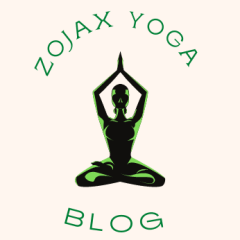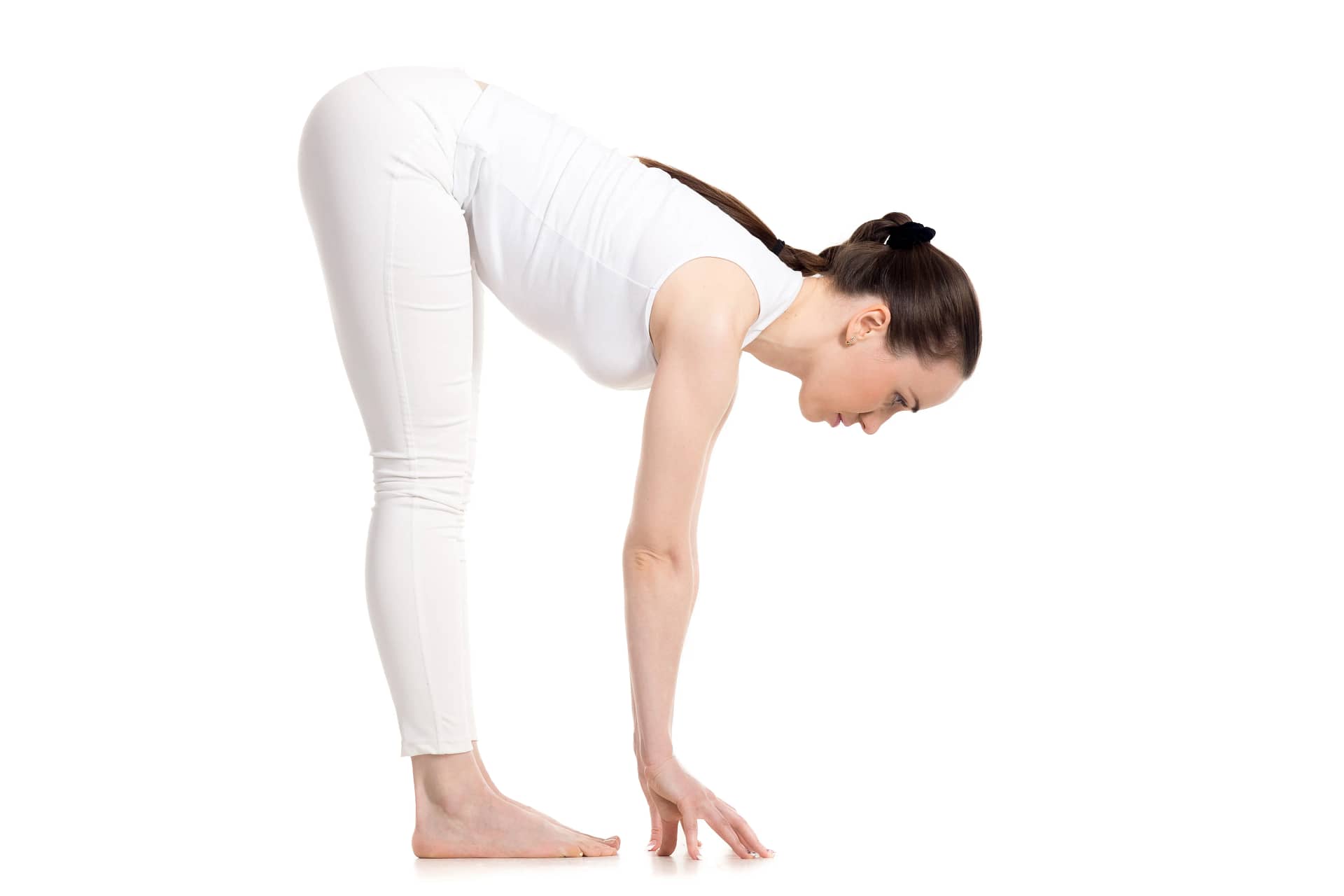In the world of yoga, numerous yoga poses offer benefits for both body and mind. One such pose is Ardha Uttanasana or Half Forward Bend , a powerful yoga pose combining strength, flexibility, and mindfulness.
Ardha Uttanasana: Exploring the Half Forward Bend
Ardha Uttanasana, or Half Forward Bend, involves folding the upper body halfway forward from a standing position. Derived from the Sanskrit words “ardha” (half) and “uttanasana” (intense stretch pose), it stretches the posterior chain of the body, including hamstrings, calves, and lower back. It also engages core muscles and promotes grounding.
Role in Sun Salutation Sequences: Connecting the Flow
Sun Salutation, or Surya Namaskar, is a popular sequence of yoga poses that serves as a warm-up or energizing practice. Ardha Uttanasana plays a crucial role in the Sun Salutation sequences by bridging the gap between the forward fold (Uttanasana) and the standing pose (Tadasana). It acts as a halfway lift, offering a moment to lengthen the spine, awaken the body, and transition smoothly between poses.
Benefits for the Body: Strength, Flexibility, and Alignment
Ardha Uttanasana provides a wide array of benefits for the body, making it an essential pose to incorporate into your yoga practice. Here are some key benefits:
- Stretches the Hamstrings and Calves: By gently folding forward, Ardha Uttanasana deeply stretches the hamstrings and calves. This helps improve flexibility in these areas, alleviates muscle tightness, and enhances overall lower body mobility.
- Strengthens the Core: Engaging the core muscles is essential in Ardha Uttanasana. This pose activates the deep abdominal muscles, including the transverse abdominis, helping to build core strength and stability.
- Improves Posture: Regular practice of Ardha Uttanasana contributes to better posture. By lengthening the spine, opening the chest, and aligning the shoulders, the pose promotes an upright and confident posture, reducing the risk of back and neck pain.
- Stimulates Digestion: Ardha Uttanasana stimulates the abdominal organs, including the digestive system. This gentle compression aids in digestion, helps alleviate bloating and constipation, and promotes a healthy metabolism.
- Calms the Mind: As a forward bending pose, Ardha Uttanasana has a grounding and calming effect on the mind. It helps to relieve stress, reduce anxiety, and improve mental clarity. The focus on breath and body awareness enhances mindfulness and promotes a sense of inner peace.
Understanding Ardha Uttanasana: Exploring the Intense Half Stretch Pose
In the realm of yoga, Ardha Uttanasana holds a significant place as a powerful and transformative posture. The name itself, derived from Sanskrit, sheds light on its essence. “Ardha” means “half,” “Uttana” translates to “intense stretch,” and “asana” represents “pose.” Let’s delve deeper into understanding Ardha Uttanasana and its benefits for the body and mind.
Meaning and Translation
Ardha Uttanasana, also known as the Intense Half Stretch Pose, embodies the essence of its name. By folding the upper body halfway forward, the pose engages and stretches specific areas, bringing a sense of intensity and release. In Sanskrit, “ardha” signifies the half position of the body, “uttana” expresses an intense stretch, and “asana” refers to a posture or pose. This combination creates a powerful blend of strength, flexibility, and mindful alignment.
Target Areas: Hamstrings, Calves, and Torso
Ardha Uttanasana primarily focuses on three key areas: the hamstrings, calves, and torso. Let’s explore the benefits and significance of stretching and engaging these regions:
- Hamstrings: The hamstrings, a group of muscles located at the back of the thighs, are a primary target in Ardha Uttanasana. The pose provides a gentle yet deep stretch, increasing flexibility and relieving tension in these muscles. Regular practice can help alleviate tightness, enhance range of motion, and improve overall lower body mobility.
- Calves: Ardha Uttanasana also extends its benefits to the calf muscles, situated at the back of the lower legs. As the body folds forward, the calves experience a soothing stretch, promoting better circulation, flexibility, and aiding in the prevention of calf muscle cramps.
- Torso: The pose engages the muscles of the torso, including the core and back muscles. While maintaining a strong and stable core, Ardha Uttanasana offers an opportunity to lengthen and strengthen the back, improving posture and spinal alignment. The gentle compression applied to the abdominal organs can also stimulate digestion and enhance overall abdominal strength.
Level of Difficulty and Suitability for Beginners
Ardha Uttanasana presents itself as a pose of moderate difficulty, making it accessible to both beginners and experienced practitioners. Here are some key considerations:
- Beginner-Friendly: Ardha Uttanasana is well-suited for beginners due to its gentle nature and adaptability. By focusing on proper alignment and listening to the body’s cues, beginners can gradually deepen their practice and experience the pose’s benefits over time.
- Modifications and Props: Beginners may find it helpful to use props like blocks or bolsters to support the hands or maintain balance. These modifications can assist in achieving a comfortable and sustainable posture.
- Progression: As practitioners gain familiarity and flexibility, they can gradually work towards straightening the legs and folding deeper into the pose. Patience and consistency are key when advancing in Ardha Uttanasana.
Benefits of Ardha Uttanasana: Enhancing Body and Mind
Ardha Uttanasana, the Intense Half Stretch Pose, offers a multitude of benefits for both the physical and mental aspects of our being. Let’s explore the remarkable advantages that this pose brings to our yoga practice and daily life.
1. Stretching the Hamstrings and Promoting Spinal Alignment
One of the primary physical benefits of Ardha Uttanasana is its ability to stretch and lengthen the hamstrings. As we fold forward, the gentle yet deep stretch targets the back of the thighs, increasing flexibility and releasing tension. Regular practice of this pose can alleviate tightness in the hamstrings, improve range of motion, and contribute to better overall lower body mobility.
Furthermore, Ardha Uttanasana promotes good spinal alignment. As we maintain a straight spine and lengthen through the crown of the head, the pose helps to strengthen the muscles along the back, supporting a healthy and upright posture. By cultivating awareness of our spinal alignment during this pose, we can carry this mindfulness into our daily activities, reducing the risk of postural imbalances and related discomfort.
2. Stimulating Abdominal Organs and Aiding Digestion
Ardha Uttanasana provides a gentle compression to the abdominal organs, including the digestive system. This compression stimulates and massages the organs, promoting healthy digestion and optimal functioning. The pose can help relieve bloating, improve metabolism, and alleviate digestive discomfort. By incorporating Ardha Uttanasana into our yoga practice, we offer a rejuvenating boost to our digestive health.
3. Increased Focus and Calming of the Mind
In addition to its physical benefits, Ardha Uttanasana holds remarkable mental and emotional advantages. As we fold forward and ground ourselves, the pose encourages a sense of introspection and tranquility. The controlled breathing combined with the gentle stretch creates a calming effect on the nervous system, helping to reduce stress and anxiety.
Practicing Ardha Uttanasana enhances our ability to focus and concentrate. The pose requires a mindful presence as we maintain balance and alignment, fostering a deeper connection between the mind and body. Through regular practice, we can carry this heightened focus into our daily activities, improving productivity and mental clarity.
4. Building Strength and Flexibility for Advanced Yoga Poses
Ardha Uttanasana serves as a foundational pose that helps prepare the body for more advanced yoga poses and sequences. The consistent practice of this pose strengthens and tones the muscles of the legs, including the hamstrings, calves, and quadriceps. The increased flexibility gained from Ardha Uttanasana opens doors to deeper variations of forward folds and seated poses.
How to do Half Forward Bend (Ardha Uttanasana)
To fully embrace the benefits of Ardha Uttanasana, it is essential to practice the pose with proper form and alignment. Follow these step-by-step instructions to cultivate a strong foundation and experience the transformative power of this pose.

Image by yanalya on Freepik
1. Starting Position:
- Begin by standing tall in Tadasana (Mountain Pose) with your feet hip-width apart and arms relaxed by your sides.
- Find a grounded connection with the earth, distributing your weight evenly through your feet.
- Engage your core and lengthen your spine, maintaining an upright posture.
2. Preparing for the Forward Fold:
- On an exhale, activate your inner thighs and begin to hinge forward from your hips.
- Keep your spine long as you fold, leading with your chest.
- As you descend, bend your knees slightly to alleviate any strain on the lower back.
3. Finding the Halfway Point:
- Once your torso is parallel to the floor, pause and find the halfway point between standing and a full forward fold.
- Maintain a flat back by lengthening your spine and drawing your shoulder blades down your back.
- Engage your core to support your lower back and prevent any excessive rounding.
4. Proper Arm and Hand Placement:
- Extend your arms forward, in line with your shoulders, with your palms facing down.
- Keep your arms active and energized, maintaining a slight micro-bend in your elbows.
- Spread your fingers wide and press into your fingertips, connecting with the energy of the pose.
5. Coordinating Breath and Movement:
- Inhale deeply, drawing the breath into your belly, expanding your rib cage.
- Exhale slowly, using the breath to deepen your fold and release tension in the hamstrings and lower back.
- Continue to sync your breath with your movements, finding a natural rhythm that allows you to flow gracefully.
6. Maintaining Balance and Alignment:
- Focus your gaze slightly forward or down, avoiding any strain on your neck.
- Press firmly into the four corners of your feet, grounding yourself and maintaining stability.
- Engage your quadriceps to lift your kneecaps, while simultaneously drawing your tailbone down to lengthen the spine.
7. Common Mistakes to Avoid:
- Avoid rounding your back excessively. Instead, prioritize lengthening through the spine and maintaining a flat back.
- Be cautious not to hyperextend your knees. Keep a gentle micro-bend to protect your joints.
- Remember to breathe deeply and avoid holding your breath. The breath is a vital component of this pose.Incorporating Ardha Uttanasana into Sun Salutation Sequences:
- To include Ardha Uttanasana in your Sun Salutation practice, start by transitioning from Mountain Pose into a forward fold (Uttanasana).
- From Uttanasana, follow the step-by-step instructions provided above to move into Ardha Uttanasana.
- Hold Ardha Uttanasana for a few breaths, focusing on alignment and the sensations in your body.
- To continue the Sun Salutation sequence, exhale and flow into the next pose, following the traditional sequence.
Modifications and Variations: Customizing Ardha Uttanasana for Your Practice
Ardha Uttanasana, with its gentle forward fold and hamstring stretch, can be tailored to suit practitioners of varying abilities and needs. Explore the following modifications and variations to make this pose accessible and enjoyable for everyone.
Modifications for Limited Flexibility or Lower Back Tightness:
- If you experience tight hamstrings or limited flexibility, place your hands on blocks or a stack of folded blankets. This elevation allows you to maintain a more comfortable position while still benefiting from the stretch.
- Alternatively, slightly bend your knees to relieve tension in the hamstrings and lower back. This modification is particularly helpful for beginners or individuals with tight muscles.
Enhancing the Pose with Props:
- To deepen the stretch and promote better alignment, consider using props such as folded blankets or yoga blocks. Place the props under your hands to bring the floor closer to you, enabling a more accessible forward fold.
- Adjust the height of the props according to your comfort level, gradually reducing their support as your flexibility improves over time.
Variations for a Deeper Forward Fold:
- If you’re seeking a more challenging variation of Ardha Uttanasana, you can incorporate these modifications:
- Interlace your fingers behind your back, extend your arms overhead, and fold forward from the hips. This variation adds an extra stretch to the shoulders and upper back.
- For advanced practitioners, you can experiment with a deeper forward fold by bending your elbows and bringing your forearms to your shins. This variation intensifies the hamstring stretch and requires additional flexibility and strength.
Safety and Precautions: Practicing Ardha Uttanasana Mindfully
While Ardha Uttanasana offers numerous benefits, it’s essential to prioritize safety and approach the practice with care. Keep the following considerations in mind to ensure a safe and enjoyable experience:
Consult a Doctor or Healthcare Professional:
- Before embarking on any new exercise routine, including yoga, it’s crucial to consult with a healthcare professional, especially if you have any pre-existing medical conditions or concerns.
- If you’re pregnant or have recently undergone surgery, it’s essential to seek guidance from your healthcare provider to determine the appropriateness and any necessary modifications for practicing Ardha Uttanasana.
You can try this option with Chair from Yoga with Lin and Leo youtube Chanell
FAQ PAGE ABOUT How to do Half Forward Bend
What is Half Forward Bend (Ardha Uttanasana)?
Half Forward Bend (Ardha Uttanasana) is a yoga pose that stretches the hamstrings and calves while strengthening the legs and spine. It is also known as Standing Half Forward Bend or Half Lift.
What are some modifications and variations of Half Forward Bend (Ardha Uttanasana)?
Some modifications and variations of Half Forward Bend (Ardha Uttanasana) include using blocks under your hands if you can’t reach the floor, bending your knees slightly if you have tight hamstrings, and placing your hands on your hips instead of on the floor.
What are some safety precautions when doing Half Forward Bend (Ardha Uttanasana)?
Some safety precautions when doing Half Forward Bend (Ardha Uttanasana) include avoiding this pose if you have a back injury or high blood pressure, not locking your knees, and keeping your head in line with your spine.




